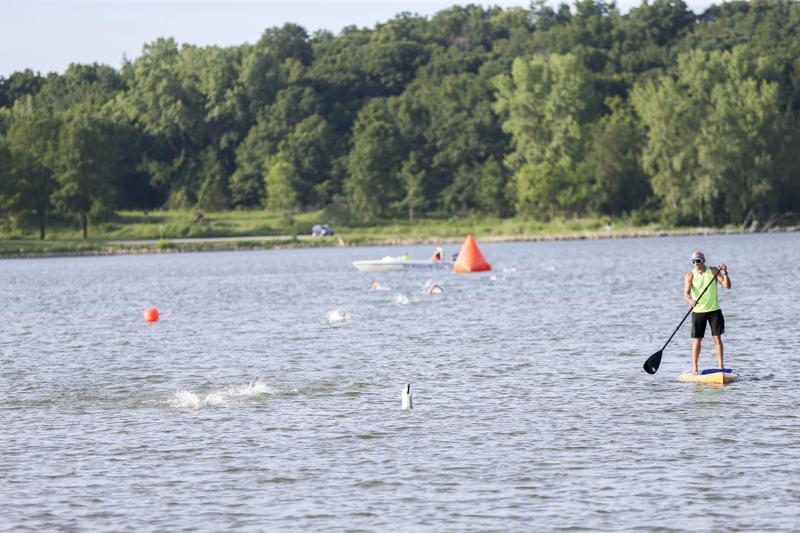If you’re looking to “beach” this Labor Day weekend, you might consider going to Pleasant Creek Recreation Area.
The beach near Palo tested within safe standards for swimming every week this summer, according to water testing by the Iowa Department of Natural Resources. But Pleasant Creek beach is in the minority — nearly 60 percent of Iowa’s 39 state beaches had at least one swim advisory since Memorial Day weekend.
Nearly all of Iowa is experiencing drought conditions, which can take a toll on water quality. Shallow, warm water promotes algae growth, and bacteria can be concentrated when water levels are down.
“It seems like the drought may have affected some systems more than others in relation to cyanotoxin production,” Dan Kendall, Iowa DNR lake and beach monitoring coordinator, said Friday about harmful algae blooms. “For example, the continuous bloom at Brushy Creek may have been caused by the drought conditions. Drought conditions can cause lake water temperature to heat up more than typical.”
The Iowa DNR collects water samples at state beaches starting from the week leading up to Memorial Day to ending the week leading up to Labor Day. The agency tests for E. coli, a bacteria that indicates the presence of other harmful bacteria, and algal toxins. Both can make humans and animals sick if they ingest water.
Over the 15 weeks of testing, there were 104 swim advisories because of high levels of E. coli and 19 advisories for toxins from algae. The Iowa DNR did not send technicians to collect water samples Aug. 21-25 because of extreme heat, so advisories in place the week before stayed put.
Of the 39 beaches tested, 23 had advisories at least one week during the summer.
Beaches with at least eight weeks of advisories are:
Lake Macbride, near Solon, had six weeks of E. coli advisories — including the last two weeks of summer.
Sign up for the once-a-week Environment & Outdoor Newsletter written by your local environmental journalists Erin Jordan and Brittney J. Miller.
 Delivered to your inbox every Thursday
Delivered to your inbox every Thursday
Bacteria has been a persistent problem at Iowa’s beaches. A Gazette and Investigate Midwest investigation last year showed a fifth of water monitoring tests administered on Iowa lakes between 2002 and 2022 exceeded the state’s threshold of 126 units of bacteria per 100 milliliters of water.
Sources of bacteria in Iowa lakes include geese that lounge on the sand, manure runoff from farm fields and septic tank discharges.
Algae blooms are influenced by the climate, which makes them more unpredictable. In 2012 — another major drought year — algal toxins exceeded the state threshold of 8 micrograms per liter of water 50 times, the investigation showed. Algae are fed by fertilizer that filters from farms through streams and groundwater.
Angelisa Belden, Iowa Environmental Council spokeswoman, visited Brushy Creek Recreation Area near Lehigh last month and posted photos of the algal bloom, which tinted the water green and created scum near the shoreline. She told a Spanish-speaking family about the swim advisory, written in English.
“If I lived near this recreation area, I’d want to be at this beach too,” Belden wrote. “But I’d also count on state leaders and those tasked with managing our state recreation areas to be looking out for ALL the Iowans who use it — making sure that critical water quality and safety information is proactively shared for everyone in the community to be safe and not just posted for those who know where to look.”

 www.thegazette.com
www.thegazette.com
The beach near Palo tested within safe standards for swimming every week this summer, according to water testing by the Iowa Department of Natural Resources. But Pleasant Creek beach is in the minority — nearly 60 percent of Iowa’s 39 state beaches had at least one swim advisory since Memorial Day weekend.
Nearly all of Iowa is experiencing drought conditions, which can take a toll on water quality. Shallow, warm water promotes algae growth, and bacteria can be concentrated when water levels are down.
“It seems like the drought may have affected some systems more than others in relation to cyanotoxin production,” Dan Kendall, Iowa DNR lake and beach monitoring coordinator, said Friday about harmful algae blooms. “For example, the continuous bloom at Brushy Creek may have been caused by the drought conditions. Drought conditions can cause lake water temperature to heat up more than typical.”
The Iowa DNR collects water samples at state beaches starting from the week leading up to Memorial Day to ending the week leading up to Labor Day. The agency tests for E. coli, a bacteria that indicates the presence of other harmful bacteria, and algal toxins. Both can make humans and animals sick if they ingest water.
Over the 15 weeks of testing, there were 104 swim advisories because of high levels of E. coli and 19 advisories for toxins from algae. The Iowa DNR did not send technicians to collect water samples Aug. 21-25 because of extreme heat, so advisories in place the week before stayed put.
Of the 39 beaches tested, 23 had advisories at least one week during the summer.
Beaches with at least eight weeks of advisories are:
- Backbone State Park, near Dundee, nine weeks (E. coli)
- Brushy Creek, near Lehigh, 10 weeks (algal toxins)
- Emerson Bay, near Milford, nine weeks (E. coli)
- Lake Darling, near Brighton, 11 weeks, (three E. coli, three algal toxins, five both)
- Lake Keomah, near Oskaloosa, 10 weeks (E. coli)
- McIntosh Woods, near Ventura, eight weeks (E. coli)
- Pine Lake South, near Eldora, 15 weeks (E. coli, with one week also algal toxins)
- Union Grove, near Gladbrook, eight weeks (E. coli)
Lake Macbride, near Solon, had six weeks of E. coli advisories — including the last two weeks of summer.
Want a weekly dose of local environmental news?
Sign up for the once-a-week Environment & Outdoor Newsletter written by your local environmental journalists Erin Jordan and Brittney J. Miller.

Bacteria has been a persistent problem at Iowa’s beaches. A Gazette and Investigate Midwest investigation last year showed a fifth of water monitoring tests administered on Iowa lakes between 2002 and 2022 exceeded the state’s threshold of 126 units of bacteria per 100 milliliters of water.
Sources of bacteria in Iowa lakes include geese that lounge on the sand, manure runoff from farm fields and septic tank discharges.
Algae blooms are influenced by the climate, which makes them more unpredictable. In 2012 — another major drought year — algal toxins exceeded the state threshold of 8 micrograms per liter of water 50 times, the investigation showed. Algae are fed by fertilizer that filters from farms through streams and groundwater.
Angelisa Belden, Iowa Environmental Council spokeswoman, visited Brushy Creek Recreation Area near Lehigh last month and posted photos of the algal bloom, which tinted the water green and created scum near the shoreline. She told a Spanish-speaking family about the swim advisory, written in English.
“If I lived near this recreation area, I’d want to be at this beach too,” Belden wrote. “But I’d also count on state leaders and those tasked with managing our state recreation areas to be looking out for ALL the Iowans who use it — making sure that critical water quality and safety information is proactively shared for everyone in the community to be safe and not just posted for those who know where to look.”
Nearly 60% of Iowa beaches had swim warnings this summer
Over the 15 weeks of testing, there were 104 swim advisories because of high levels of E. coli and 19 advisories for toxins from algae.


